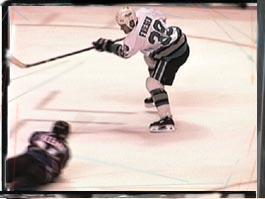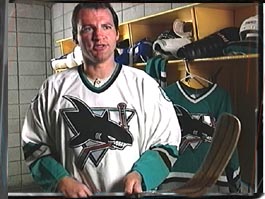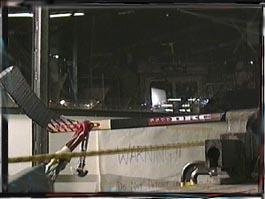|


|
San Jose Sharks Forward Jeff Friesen releases a quick wrist shot past a
diving defenseman.
|
|
"How do you hit a puck 100 miles per hour?" was
one of the first questions we asked when we began to examine the science
of hockey. The slapshot is certainly one of the most exciting aspects of
the game, and when properly implemented, the puck becomes the fastest moving
object in any major professional team sport. Players talk about what goes
into slapshots and wrists shots, and the scientists in this section will
examine the physics behind shooting the puck.
In this section, there are RealAudio and video
clips from San Jose Sharks Forward Tony Granato, Sharks Defenseman, Doug
Bodger and Exploratorium Scientist Thomas Humphrey.
|
|
Slapshots
Every year before the NHL All-Star game players' slapshots
are clocked with a radar gun. The San Jose Sharks have arguably the fastest
slapshot in the league in defenseman Al Iafrate. He has been clocked at
well over 100 miles (160 km) per hour. So how does he hit a puck that fast?
Where does the power come from? Defenseman Doug Bodger believes that a good
slapshot is mostly technique and that the power comes from a weight transfer.
The weight of the player transfers from his back legs right through to the
stick in his hands.Using a high-speed video camera we examined Sharks forward
Jeff Friesen's slapshot and found that this was true, but there was more
going on than just that.
|

|
San Jose Sharks Doug Bodger talks about the slapshot.
|

|
San Jose Sharks Forward Jeff Friesen demonstrates
a slapshot
|

1MB
|
|
|
Friesen hit the ice a good foot or more before the stick came
in contact with the puck. This caused the stick to "bow" considerably.
When the stick did come in contact with the puck, the "bow" was
released, snapping the stick towards the puck just as Friesen was following
through with his swing (and transfering his weight). The overall motion
is combined with the stick snapping back, releasing energy into the puck.
There is also a slight snap of the wrists at the end of the motion--allowing
the puck to spin off the stick. This gyroscopic action allows the puck to
remain stable in flight, which helps the shot's accuracy
|
|

|
In the name of science, we decided to sacrifice a brand new stick.
|
|
Breaking your stick
Just how strong is a hockey stick? After watching Jeff
Friesen's stick bend we wanted to see what takes to break a hockey stick.
In the Exploratorium shop, we used a vise, a spring scale, and a block and
tackle. The particular model we used was a fiberglass stick with wooden
replacement blades. After placing the stick in the vise we pulled on a rope
connected to the block and tackle and the spring scale. To make a long story
short, it took nearly one ton of force to break this particular hockey stick!
Anyone who watches the game knows that players' sticks are broken often.
In fact, most players tape up three or four sticks before a game just to
make sure they have enough.
|
|
Click the "forward"
button below to continue.
|

©
Exploratorium
|